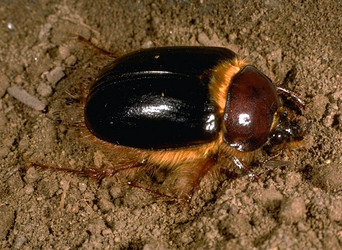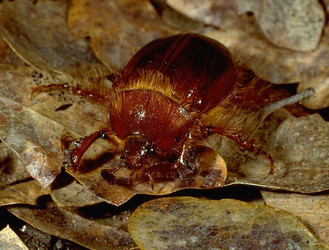Pleocomidae
Pleocoma
Rain beetles
Clarke H. Scholtz and D. Jonathan Browne- Pleocoma australis
- Pleocoma badia
- Pleocoma behrensi
- Pleocoma bicolor
- Pleocoma blaisdelli
- Pleocoma carinata
- Pleocoma conjungens
- Pleocoma crinita
- Pleocoma dubitabilis
- Pleocoma fimbriata
- Pleocoma hirticollis
- Pleocoma hoppingi
- Pleocoma linsleyi
- Pleocoma marquai
- Pleocoma minor
- Pleocoma octopagina
- Pleocoma oregonensis
- Pleocoma puncticollis
- Pleocoma rickseckeri
- Pleocoma rubiginosa
- Pleocoma shastensis
- Pleocoma simi
- Pleocoma sonomae
- Pleocoma staff
- Pleocoma trifoliata
- Pleocoma tularensis
- Pleocoma venturae
Introduction
Pleocomidae are a monotypic family of about 33 species which are restricted to western North America. Males are winged and females wingless; neither feeds. Adults are usually active after autumn rains, hence the common name rain beetles. Larvae are slow-developing and long-lived (8-12 years), and moult several times (9+ instars). They feed on live roots of trees and grasses and are well adapted for burrowing (Ellertson & Ritcher 1959).
Characteristics
Adults are characterized by: 10-segmented antennae with a 3-segmented club; eye without a canthus, and with eucone ommatidia; intermandibular projection present; mandibles toothed, without prostheca and molar area; maxilla with lobed galea and lacinia terminating in two teeth, palpi 4-segmented; labium consists of fused mentum and prementum, and a triangular, partly bilobed ligula; tentorium "invaginated"; protrochantin exposed; procoxal cavities open; mesocoxal cavities open; generalized mesothoracic spiracles and intersegmentalia; wings with radial cell eyelet-like, distally strengthened (later progressively narrower and more obliquely oriented); densely crimped anterior margin and radial bend present; apical hinge reinforced by RA3+4 being "pinched" with the anterior margin; all radial branches retained; r3 lost; r4 shifted proximally, curved distad and ending on RP1+2 instead of RP (later replaced by stiffened membrane); RA4 and RP1 approach each other and run in parallel; central folding field triangular; rp-mp2 completely lost which renders the medial hook narrow and pointed; RP3+4 and medial spur adjacent and both reaching the posterior margin; CuA3+4 reduced; AA1+2 spike-like, but primitively recovers its course and reaches the posterior margin; AP1+2 reduced; two short jugal veins present; 1Ax broad, ventral projection and FSc1 very short and narrow, distal embayment weakly concave, and PRR articulation very weak; 2Ax proximal lobe very small, strongly depressed below the ridge, distal lobe very large and harp-shaped, anterior section of the dorso-proximal ridge absent, dorso-distal ridge weakly elevated, feebly distinct and the anterior section very short, medial groove very weak anteriorly, FR strikingly broadly ovoid and large, and very broadly articulated with the distal ridge and lobe; median plate broadly articulated with 1-3Ax, FM1 and FM2 separated by membrane and FM2 small; 3Ax head dorsally very broad and moderately convex, anterior margin convex, FCu very large, posterior section of the neck ridge absent, AXCu present as a very slender anteriad extension along the proximal margin of head, tail very narrow and convex, window or medial weakening absent, and suture line between AXA, AXJ and FJ present; 1BP with HP very weakly curved postero-dorsad, BScA moderately large and oriented antero-distad, ScA large and broad, separated from BScA by a deep concavity, BR broadly open, long, partially depressed below BScA, with a very small proximal arch, an indistinct br and distal arch absent; 2BP large, broad, moderately sclerotized with BMA distinct, strongly convex, partially anterior to BMP, BMA and BMP completely fused posteriorly and incompletely so anteriorly, BMP flattened and strongly depressed below BMA, BMP-BCuA brace slender, moderately sclerotized and MA weak but present; tarsal empodium absent; 5 visible abdominal ventrites; abdominal spiracles situated in pleural membrane, all functional; male genitalia a simple symmetrical trilobe; genital capsule distinct; six ovarioles present per ovary; karyotype 9+Xyp (Scholtz et al. in preparation).
Larvae are characterized by: 3-segmented antennae; a distinct fronto-clypeal suture; stemmata present; 2-segmented labial palpi; maxillary galea and lacinia distinctly separate, galea 1-segmented; 3-segmented maxillary palpi; maxillary/mandibular stridulatory areas present; anterior margin of labrum evenly rounded; epipharyngeal tormae fused and more or less symmetrical; legs 4-segmented, with claw; stridulatory apparatus present on the legs; spiracles with closing apparatus; elateroid ecdysial process occurs; biforous spiracles present; abdomen characterized by an unmodified, subterminal 9th segment and a terminal 10th segment, with distinct tergum and sternum bordering a transverse anal opening; 3 thoracic ganglia, joined by distinct connectives present (Scholtz et al. in preparation).
Relationships of Pleocomids to other Scarabaeoidea
Pleocomidae's composition and position relative to the other scarabaeoid families have been the cause of some discussion over the years. Horn (1883, 1888) and Davis (1934) stated or implied that although Pleocoma was most closely related to Geotrupidae it was unique and that it probably justified placement in a subfamily of its own [within Scarabaeidae]. Leng (1920) and Cazier (1953) included two genera, Pleocoma and Acoma in the subfamily Pleocominae. Howden (1958) expressed doubt about the placement of Acoma in the Pleocominae and it has more or less been in limbo ever since (although Browne (1993) and Browne & Scholtz (in preparation) unequivocally place Acoma in the Melolonthinae).
Paulian (1941) was the first to try to place Pleocoma phylogenetically in the superfamily. He concluded that Pleocoma was most closely related to some Geotrupidae and should, consequently, be in the same family, as the subfamily Pleocominae. Ritcher (1947) agreed with Paulian. However, Paulian's assessment of relationship was based primarily on the shared plesiomorphic condition of 11-segmented antennae, and on male genitalia. Ritcher (1966) reassessed the relationship with Geotrupidae and presented larval evidence why Pleocoma should be treated as a separate subfamily in the Scarabaeidae but one closely related to the Geotrupinae. Howden (1982) tentatively agreed with this association and identified two characters which he claimed were synapomorphic between Geotrupidae and Pleocoma. However, Howden (1982) pondered whether some other characters, notably antennal club number, were more melolonthine- than geotrupid-like but concluded, somewhat uncertainly, that the similarities between Melolonthinae and Pleocoma are probably convergent. Zunino (1984) treated Pleocomidae as the outgroup of the Geotrupidae. Crowson (1981) and Lawrence (1982) accorded Pleocomidae family rank and placed them amongst the primitive scarabaeoids. More recently Browne (1991, 1993) and Browne & Scholtz (1995), based on wing characters, and Browne & Scholtz (in preparation), based on all available adult, larval and biological characters, placed Pleocomidae as the sister group of the Bolboceratidae.
References
Browne, D.J. 1991. Phylogenetic significance of the hind wing articulation of the Geotrupidae (Coleoptera: Scarabaeoidea). Pretoria: M.Sc. Thesis, University of Pretoria.
Browne, D.J. 1993. Phylogenetic significance of the hind wing basal articulation of the Scarabaeoidea (Coleoptera). Pretoria: Ph.D. thesis, University of Pretoria.
Browne, D.J. & Scholtz, C.H. 1995. The phylogeny of the families of Scarabaeoidea (Coleoptera) based on characters of the hind wing articulation, wing base and wing venation. Systematic Entomology 23:
Cazier, M.A. 1953. A review of the scarab genus Acoma (Coleoptera, Scarabaeidae).American Museum Novitates 1624: 1-13.
Crowson, R.A. 1981. The biology of the Coleoptera. London: Academic Press.
Davis, A.C. 1934. A revision of the genus Pleocoma. Bulletin of the Southern California Academy of Sciences 33(3):123-130: 34(1): 4-36.
Ellertson, F.E. & Ritcher, P.O. 1959. Biology of rain beetles, Pleocoma spp., associated with fruit trees in Wasco and Hood River Counties. Oregon Agricultural Experiment Station Bulletin 44: 1-42.
Horn, G.H. 1883. Pleocoma Lec. Its systematic position and indication of new species. Entomologica Americana 3: 233-235.
Horn, G.H. 1888. Review of the species of Pleocoma with a discussion of its systematic position in the Scarabaeidae. Transactions of the American Entomological Society 15: 1-18.
Hovore, F. T. 2002. Pleocomidae. pp. 20-22 in Arnett, R.H., Jr., M. C. Thomas, P. E. Skelley and J. H. Frank. (eds.). American Beetles. Volume 2. Polyphaga: Scarabaeoidea through Curculionoidea. CRC Press LLC, Boca Raton, FL. xiv + 861 pp.
Howden, H.F. 1958. Species of Acoma Casey having a three-segmented antennal club (Coleoptera: Scarabaeidae). Canadian Entomologist 90(7): 377-401.
Howden, H.F. 1982. Larval and adult characters of Frickius Germain, its relationship to the Geotrupini, and a phylogeny of some major taxa in the Scarabaeoidea (Insecta: Coleoptera). Canadian Journal of Zoology 60(11): 2713-2724.
Lawrence, J.F. 1982. Coleoptera. In: Parker, S.P. (Ed.) Synopsis and classification of living organisms. New York: McGrawhill.
Leng, C.W. 1920. Catalogue of the Coleoptera of America, north of Mexico. New York: John D. Sherman.
Paulian, R. 1941. La position systmatique du genre Pleocoma Le Conte (Col. Scarabaeidae).Revue Francaise de Entomologique 8: 151-155.
Ritcher, P.O. 1947. Larvae of Geotrupinae with keys to tribes and genera (Coleoptera: Scarabaeidae). Kentucky Agricultural Experiment Station Bulletin 506: 1-27.
Ritcher, P.O. 1966. White grubs and their allies. A study of North American scarabaeoid larvae. Studies in Entomology No. 4. Corvallis: Oregon State University Press.
Zunino, M. 1984. Sistematica generica dei Geotrupinae (Coleoptera, Scarabaeoidea: Geotrupidae), filogenesi della sottofamiglia e considerazioni biogeografiche. Bollettino del Museo Regionale di Scienze Naturali - Torino 2(1): 9-162.
Title Illustrations

| Scientific Name | Pleocoma tularensis |
|---|---|
| Location | Westfall Road (Mariposa County, California, US) |
| Creator | Robert Potts |
| Source Collection | CalPhotos |
| Copyright |
© 2002 California Academy of Sciences

|
| Scientific Name | Pleocoma hoppingi |
|---|---|
| Location | Westfall Road (Mariposa County, California, US) |
| Creator | Robert Potts |
| Source Collection | CalPhotos |
| Copyright |
© 2002 California Academy of Sciences

|
About This Page
Clarke H. Scholtz

University of Pretoria, South Africa
D. Jonathan Browne

University of Cape Town, South Africa
Correspondence regarding this page should be directed to Clarke H. Scholtz at and D. Jonathan Browne at
Page copyright © 2005 Clarke H. Scholtz and D. Jonathan Browne
All Rights Reserved.
Citing this page:
Scholtz, Clarke H. and D. Jonathan Browne. 2005. Pleocomidae. Pleocoma. Rain beetles. Version 01 January 2005 (under construction). http://tolweb.org/Pleocoma/9543/2005.01.01 in The Tree of Life Web Project, http://tolweb.org/










 Go to quick links
Go to quick search
Go to navigation for this section of the ToL site
Go to detailed links for the ToL site
Go to quick links
Go to quick search
Go to navigation for this section of the ToL site
Go to detailed links for the ToL site